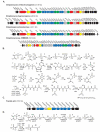Conserved biosynthetic pathways for phosalacine, bialaphos and newly discovered phosphonic acid natural products
- PMID: 26328935
- PMCID: PMC4731264
- DOI: 10.1038/ja.2015.77
Conserved biosynthetic pathways for phosalacine, bialaphos and newly discovered phosphonic acid natural products
Abstract
Natural products containing phosphonic or phosphinic acid functionalities often display potent biological activities with applications in medicine and agriculture. The herbicide phosphinothricin-tripeptide (PTT) was the first phosphinate natural product discovered, yet despite numerous studies, questions remain surrounding key transformations required for its biosynthesis. In particular, the enzymology required to convert phosphonoformate to carboxyphosphonoenolpyruvate and the mechanisms underlying phosphorus methylation remain poorly understood. In addition, the model for non-ribosomal peptide synthetase assembly of the intact tripeptide product has undergone numerous revisions that have yet to be experimentally tested. To further investigate the biosynthesis of this unusual natural product, we completely sequenced the PTT biosynthetic locus from Streptomyces hygroscopicus and compared it with the orthologous cluster from Streptomyces viridochromogenes. We also sequenced and analyzed the closely related phosalacine (PAL) biosynthetic locus from Kitasatospora phosalacinea. Using data drawn from the comparative analysis of the PTT and PAL pathways, we also evaluate three related recently discovered phosphonate biosynthetic loci from Streptomyces sviceus, Streptomyces sp. WM6386 and Frankia alni. Our observations address long-standing biosynthetic questions related to PTT and PAL production and suggest that additional members of this pharmacologically important class await discovery.
Figures






Similar articles
-
Molecular cloning, sequence analysis, and heterologous expression of the phosphinothricin tripeptide biosynthetic gene cluster from Streptomyces viridochromogenes DSM 40736.Antimicrob Agents Chemother. 2005 Jan;49(1):230-40. doi: 10.1128/AAC.49.1.230-240.2005. Antimicrob Agents Chemother. 2005. PMID: 15616300 Free PMC article.
-
Three thioesterases are involved in the biosynthesis of phosphinothricin tripeptide in Streptomyces viridochromogenes Tü494.Antimicrob Agents Chemother. 2008 May;52(5):1686-96. doi: 10.1128/AAC.01053-07. Epub 2008 Feb 19. Antimicrob Agents Chemother. 2008. PMID: 18285472 Free PMC article.
-
Biosynthetic gene cluster of the herbicide phosphinothricin tripeptide from Streptomyces viridochromogenes Tü494.Appl Environ Microbiol. 2004 Dec;70(12):7093-102. doi: 10.1128/AEM.70.12.7093-7102.2004. Appl Environ Microbiol. 2004. PMID: 15574905 Free PMC article.
-
Phosphinothricin-tripeptide biosynthesis: an original version of bacterial secondary metabolism?Phytochemistry. 2009 Oct-Nov;70(15-16):1787-800. doi: 10.1016/j.phytochem.2009.09.002. Epub 2009 Oct 29. Phytochemistry. 2009. PMID: 19878959 Review.
-
[Elements of regulatory systems of antibiotic biosynthesis in Streptomyces].Genetika. 1997 Nov;33(11):1461-77. Genetika. 1997. PMID: 9480210 Review. Russian.
Cited by
-
Phosphonoalamides Reveal the Biosynthetic Origin of Phosphonoalanine Natural Products and a Convergent Pathway for Their Diversification.Angew Chem Int Ed Engl. 2024 Aug 5;63(32):e202405052. doi: 10.1002/anie.202405052. Epub 2024 Jul 9. Angew Chem Int Ed Engl. 2024. PMID: 38780891 Free PMC article.
-
Structural basis of the nonribosomal codes for nonproteinogenic amino acid selective adenylation enzymes in the biosynthesis of natural products.J Ind Microbiol Biotechnol. 2019 Mar;46(3-4):515-536. doi: 10.1007/s10295-018-2084-7. Epub 2018 Oct 5. J Ind Microbiol Biotechnol. 2019. PMID: 30291534 Review.
-
Crossroads of Antibiotic Resistance and Biosynthesis.J Mol Biol. 2019 Aug 23;431(18):3370-3399. doi: 10.1016/j.jmb.2019.06.033. Epub 2019 Jul 6. J Mol Biol. 2019. PMID: 31288031 Free PMC article. Review.
-
Genome sequence of the bialaphos producer Streptomyces sp. DSM 41527 and two putative phosphonate antibiotic producers Streptomyces sp. DSM 41014 and DSM 41981 from the DSMZ strain collection.Access Microbiol. 2024 Apr 19;6(4):000770.v3. doi: 10.1099/acmi.0.000770.v3. eCollection 2024. Access Microbiol. 2024. PMID: 38737806 Free PMC article.
-
Identification of the Biosynthetic Gene Cluster for the Organoarsenical Antibiotic Arsinothricin.Microbiol Spectr. 2021 Sep 3;9(1):e0050221. doi: 10.1128/Spectrum.00502-21. Epub 2021 Aug 11. Microbiol Spectr. 2021. PMID: 34378964 Free PMC article.
References
-
- De Clercq E. The Holy Trinity: the acyclic nucleoside phosphonates. Adv Pharmacol. 2013;67:293–316. - PubMed
Publication types
MeSH terms
Substances
Grants and funding
LinkOut - more resources
Full Text Sources
Other Literature Sources
Molecular Biology Databases

